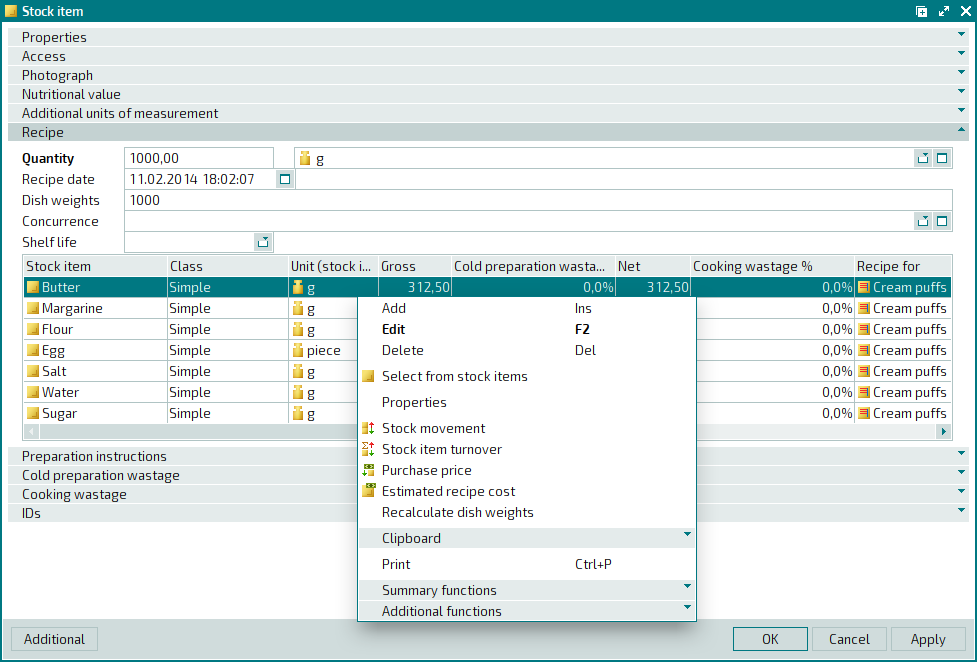- Menu
- Menu
- Store
- Cost price
- Stock-out records
- Stock movement records
- Stock adjustment records
- Production records
- Stocktaking records
- Sales records
- Stock movement
- Stock item turnover
- Purchase price
- Processing wastage percentages in recipes
- Recipes containing stock items operational report
- Stock item groups
- Stock item types
- Stock item categories
- Stock item concurrences
- Stock item units of measurement
- Stock item unit of measurement groups
© Tillypad, 2008-2015
The Recipe panel displays a list of stock items used to prepare a compound or semi-processed item. This list also shows ingredient volumes and cooking wastage, as well as other useful information.

Panel fields:
Quantity is the quantity of the stock item required for the recipe (expressed in preset units of measurement). This is a required field.
Unit (stock item) is the unit of measurement for the stock item. This is a required field.
Please select a unit in the window.
By default, it is the same as the stock item unit of measurement selected in the Unit (stock item) field of the Properties panel.
Recipe date refers to the date when the recipe was created or last modified.
Dish weights shows the weight of the dish as specified in the menu. This field shows the weight of an output compound stock item in grams.
For soups served with a piece of meat or fish, ingredient volumes are separated by a slash (for example,
40/300). For main courses, it is necessary to indicate the volume of the main dish plus those of any sides, sauces, or gravies. For example, the value100/80/25indicates that100 grefers to the entree,80 gto the side dish and25 gto the sauce.Concurrence is the stock item concurrence assigned to the compound stock item.
You can select this value in the window.
Stock item concurrences determine how elements of compound stock items are added to the specifications of stock records. A stock item concurrence is applied if the By stock item concurrence value is set to the Recipe mode field in entry or editor windows where store documents can be modified.
Shelf life refers to the period of time within which the dish prepared by this recipe should be consumed.
If it is less than 24 hours, the shelf life is listed in the format
HH:MM:SS. If more than 24 hours, it appears in the formatDD days HH:MM:SS.
Data grid columns:
Stock item is the stock item (ingredient) included in the recipe of the compound stock item.
Unit (stock item) denotes the unit of measurement for the recipe item.
Gross refers to the gross quantity of the stock item required to prepare the compound item.
Cold preparation wastage % denotes the quantity of the stock item modified during cold preparation.
Net is the quantity of the stock item after cold processing.
Cooking wastage % designates the amount by which the quantity changes as a result of cooking.
Yield is the quantity of the stock item left after cooking.
Comment is a brief comment on the recipe item.
Type indicates the stock item type to which the recipe item belongs.
Class is the class to which the recipe item belongs.
Recipe for is the compound item whose recipe contains the selected stock or semi-finished item.
Substitutes indicates whether automatic substitution of the stock item in sales record specifications is possible.
If substitutes for the stock item are specified in the directory or in the dish/compound stock item's recipe, this cell in the column will contain the value Yes. If no substitutes have been prescribed, the cell remains empty.
Concurrence determines how the stock item (ingredient) is included in the recipe (with recipe, without recipe or according to stock item concurrence).
Index indicates the order in which the ingredient is added during preparation.
Order of weights indicates the order in which the ingredient's yield is shown in the Dish weights field.
Category refers to the stock item category to which the recipe item belongs.
Stock item group is the stock item group to which the recipe item belongs.
Protein shows the protein content of the stock item included in the recipe.
Fats shows the fat content of the stock item included in the recipe.
Carbohydrates shows the carbohydrate content of the stock item included in the recipe.
Calorie content shows the nutritional value of the stock item included in the recipe.
Context menu commands:
(Ins) – adds a recipe item.
(F2) – edits the selected recipe items.
(Del) – deletes items from the recipe.
– selects stock items from the directory to be added sequentially to the recipe.
– opens the editor window for the selected stock item(s).
– displays an operational report on movement of the selected stock items.
– opens an operational report on stock turnover of the selected stock items.
– opens an operational report on purchase prices of the selected stock items.
– recalculates the volume of the stock item with recipe based on the ingredients included in its recipe.
– menu with the commands to operate the clipboard.
(Ctrl+P) – generates print layouts.
– menu with the commands to manage the summary functions of the data grid.
– menu with the commands to operate the data grid.
The and entry windows are used for adding new recipe items to stock items. The and editor windows are used to change the parameters of stock items included into the recipe.
The confirm permanent deletion prompt appears when you delete stock items from a recipe.

